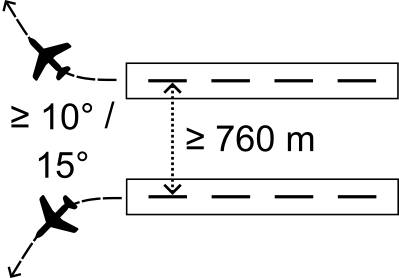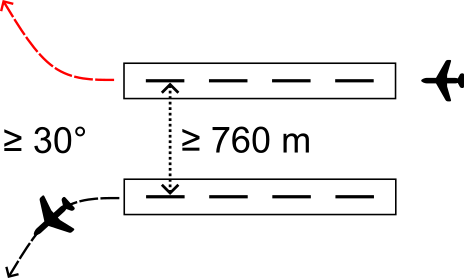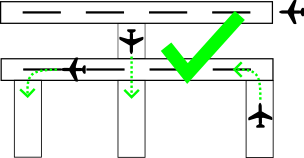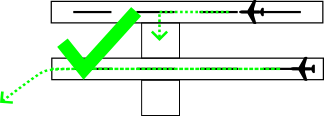Separation on parallel runways
General
Airports may have multiple parallel runways to increase capacity. In Germany, there are seven such airports: Frankfurt (EDDF), Munich (EDDM), Düsseldorf (EDDL), Berlin (EDDB), Cologne (EDDK), Leipzig (EDDP), and Hanover (EDDV).
Strict rules determine how parallel runways can be used concurrently for takeoffs and/or landings, and what minimum separations must be maintained. In Germany, these requirements are set by the EU (EASA), and can be found at this document from page 586 (AMC1‑AMC4 ATS.TR.255 – Operations on parallel or near‑parallel runways).
Additionally, the German air navigation service provider (DFS) may implement further requirements or deviate from EASA rules, as long as safety isn't compromised. For instance, EASA regulations don’t cover runways spaced less than 760 m apart—a condition that applies at EDDF and EDDL. Consequently, the DFS has established its own rules for these cases.
This article explains both the EASA rules and local deviations. Only those EASA rules relevant to German airports are covered here.
Modes of Operation
There are four main modes of operation for parallel runways:
The first two modes are related to arriving aircraft:
- Independent parallel approaches
- Dependent parallel approaches
The next mode is related to departing aircraft:
- Independent parallel departures
The last mode is related to the dependency between departing and arriving aircraft:
- Segregated parallel operations
Each mode must be individually authorized for each airport in Germany by a rigorous regulatory procedure. The approval depends on whether the operational benefit justifies the effort. For instance, independent parallel approaches are not approved at Hannover, even though conditions might otherwise permit them.
Independent Parallel Approaches
Independent parallel approaches are approaches to parallel runways where no prescribed radar separaration exists between arriving aircraft on parallel runways.
Independent parallel approaches may only be conducted if all of the following conditions are met:
Requirements Independent parallel approaches (click to expand)
-
Separate controllers must be responsible for the separation of aircraft for each runway.
-
As soon as an aircraft is on the frequency of the approach controller, the controller must inform the pilot as early as possible that independent parallel approaches are in progress. This can also be done via the ATIS.
-
The runway distance must be at least 1,035 meters.
-
The ATC radar must have a certain accuracy depending on the runway spacing. (Not applicable on VATSIM).
-
The instrument approach flown during final approach must be one of the following:
-
A precision approach (ILS, GLS, SBAS CAT I)
-
An approach with vertical guidance (APV), designed according to the RNP or RNP AR navigation specification and only after subject to a safety assessment
-
-
The missed approach courses of the approaches to the respective parallel runways must diverge by at least 30 degrees.
-
Affected aircraft must be informed as early as possible of the expected runway and the instrument approach procedure.
-
The final approach course must be flown via:
-
A published approach procedure enabling the final approach via the Initial Approach Fix (IAF) or Intermediate Fix (IF), or
-
Radar vectors, provided that:
-
The aircraft intercepts the final approach course at an angle of no more than 30 degrees
-
The aircraft flies straight and level for at least 1 NM before intercepting the final
-
The aircraft flies at least 2 NM on the final approach course in level flight before beginning descent on the glide path
-
-
-
A Non-Transgression Zone (NTZ) with a minimum width of 610 meters must be displayed on radar between the runways.
-
Before two aircraft are established on their respective final approach courses, there must be at least 1,000 feet of vertical separation or at least 3 NM of horizontal separation between them.
-
Between two aircraft on the same final approach course, the minimum separation must be 3 NM, or 2.5 NM if locally approved. Wake turbulence separation must also be applied if applicable.
Independent parallel approaches are permitted at the following airports in Germany, provided all requirements are met: EDDF (ILS, GLS), EDDM (ILS, RNP), EDDB (ILS), and EDDP (ILS).
Requirement (1) — that separate controllers be responsible for spacing to each runway — is not mandatory for EDDM due to a local exemption.
On VATSIM, the NTZ (Non-Transgression Zone) is often forgotten during independent parallel approaches. However, it is a required element (provided it is included in the NAV package). If one of the parallel aircraft enters the NTZ, the other aircraft must be issued traffic information and, if necessary, instructed to go around.
In the event of a missed approach, the parallel aircraft are procedurally separated as long as the published missed approach procedure is not deviated from.
Dependent Parallel Approaches
Dependent parallel approaches are approaches to parallel runways where a certain prescribed radar separaration exists between arriving aircraft on parallel runways.
Dependent parallel approaches may only be conducted if all of the following conditions are met:
Requirement dependent parallel approaches (click to expand)
-
The runway distance must be at least 915 meters.
-
The final approach course must be flown via:
-
A published approach procedure enabling final approach through the Initial Approach Fix (IAF) or Intermediate Fix (IF), or
-
Radar vectors
-
-
The ATC radar must meet specific accuracy requirements. (Not applicable on VATSIM.)
-
The instrument approach aligning the aircraft on final must be one of the following:
-
A precision approach (ILS, GLS, SBAS CAT I), or
-
An approach with vertical guidance (APV) designed in accordance with the RNP or RNP AR navigation specification and subjected to a safety assessment
-
-
Relevant aircraft must be informed that approaches are being conducted to both runways.
-
The missed approach courses of the respective parallel runway approaches must diverge by at least 30 degrees.
-
Before two aircraft are established on final approach, there must be either:
-
1,000 feet of vertical separation, or
-
3 NM of horizontal separation between them
-
-
Between two aircraft on the same final approach course, the minimum separation must be 3 NM, or 2.5 NM if locally regulated. Wake turbulence separation must also be applied, if necessary.
-
The minimum radar separation between two aircraft on parallel runways depends on the runway spacing:
-
2 NM if the runways are more than 2,529 meters apart
-
1.5 NM if the runways are less than 2,529 m but more than 1,097 m apart
-
1 NM if the runways are less than 1,097 m but more than 915 m apart
-
Anyone who read the last requirement carefully might wonder why the minimum separation decreases when two runways are closer together. At first glance, this may seem illogical. However, it is actually due to simple geometry: When two runways are close together, a minimum separation of x results in a certain longitudinal separation between the aircraft (i.e., how far apart they are along their flight path). If the runways are moved farther apart but the same minimum separation is maintained, the aircraft would eventually be flying side by side, since the separation refers to the direct distance between them. Therefore, the minimum separation must increase with greater runway spacing to ensure that aircraft still maintain a certain longitudinal separation, i.e., they fly one behind the other.
In Germany, dependent parallel approaches are authorized at the following airports, provided all requirements are met:
EDDF (ILS, GLS), EDDB (ILS), EDDP (ILS), EDDV (ILS).
A minimum separation of 1.5 NM between two aircraft on parallel approaches applies at all of these airports.
In the event of a missed approach, the aircraft are procedurally separated as long as the published missed approach procedure is not deviated from.
If neither independent nor dependent parallel approaches are possible (e.g., due to insufficient runway spacing at EDDL and EDDK), the two final approaches must be treated as if they were to a single runway in terms of radar separation. That means a minimum of 3 NM, or 2.5 NM if locally regulated, must be maintained between two aircraft on parallel runways (see below).
This mode is known as "alternating" or "staggered" approaches.
If the runway spacing is less than 760 meters, wake turbulence separation may also need to be applied.
Independent Parallel Departures
Independent parallel departures involve simultaneous takeoffs from parallel runways, where no prescribed radar separation exists between the parallel departures.
Independent parallel departures may only be conducted if all of the following requirements are met:
Requirements for independent parallel departures (click to expand)
-
Runway distance must be at least 760 meters
-
The departure tracks must diverge by at least:
-
15 degrees immediately after takeoff, or
-
10 degrees, provided that:
-
Both aircraft are flying RNAV or RNP departure routes, and
-
The turn begins no later than 2 NM after the end of the runway
-
-
-
ATC radar capable of identifying aircraft within 1 NM from the runway end is available
In Germany, independent parallel departures are permitted at the following airports, if all conditions are met:
EDDM, EDDB, EDDP
If independent parallel departures are not possible (e.g., generally at EDDF, EDDL, EDDK, EDDV), then radar separation of 3 NM must be applied between departures.
For runway distance less than 760 meters, wake turbulence separation may also be required.
Segregated Parallel Operations
Segregated parallel operations refer to the simultaneous use of one runway for departures and the other for landings. Each runway may be used exclusively for takeoffs, exclusively for landings, or for both.
Segregated parallel operations may only be conducted if all of the following conditions are met:
Requirements for Segregated Parallel Operations (click to expand)
-
The runway distance must be at least 760 meters. This minimum can be reduced by 30 meters for every 150 meters the arrival runway is ahead of the departure runway. Conversely, it must be increased by 30 meters for every 150 meters the arrival runway is behind the departure runway.
-
The departure tracks must diverge immediately after takeoff by at least 30 degrees from the missed approach course of the parallel runway.
-
The instrument approach flown on final must be one of the following:
-
A precision approach (ILS, GLS, SBAS CAT I) and/or a lateral guidance approach (RNP)
-
A Surveillance Radar Approach (SRA)
-
A visual approach
-
In Germany, segregated parallel operations are permitted at the following airports, if all conditions are met:
EDDF, EDDM, EDDL, EDDB, EDDP.
Requirement (1), so the minimum runway spacing of 760 m, is not required at EDDF (center and southern runway) and EDDL due to local exemptions. Although the runway spacing there is less than 760 meters, segregated operations can still be conducted under certain conditions, as detailed in local SOPs.
If segregated operations are not possible (e.g., at EDDV, EDDK, or due to insufficient divergence between a specific SID and the missed approach course), the parallel runways must be treated like a single runway for the in terms of departure and arrival separation. In that case, runway separation between departures and arrivals must be applied.
However, ground movements (e.g., behind a landing, crossing, line-up) are exempt and may still occur in parallel with an ongoing departure or landing.
Here is a summary of what is and isn't allowed if segregated parallel operations are not permitted:
|
A parallel line-up, runway crossing, or vacating is always allowed during a landing |
 A departure must have overflown the runway end (or turned away) before an aircraft on the parallel runway crosses the threshold to land A departure must have overflown the runway end (or turned away) before an aircraft on the parallel runway crosses the threshold to land |
|
If a landing is assured, a departure on the parallel runway may be cleared for takeoff. |
If an arrival crosses the threshold and the parallel departure hasn't yet overflown the runway end (or turned away), this would be a loss of separation if segregated parallel operations are not approved. |
Reduced radar separation on final approach
Even when parallel runways are available, independent or dependent parallel approaches may not always be possible. In such cases, the standard radar separation of 3 NM must be met.
However, under certain conditions, the minimum radar separation on final approach can be reduced. Two cases are distinguished:
-
Reduced radar separation on final approaches to parallel runways
-
Reduced radar separation on the same final approach
Reduced Radar Separation on Final Approaches to Parallel Runways
The longitudinal separation between two aircraft on final approaches to parallel runways may be reduced to 2.5 NM, if all of the following conditions are met:
Requirements Reduced Radar Separation on Final Approaches to Parallel Runways (click to expand)
-
Both aircraft must be within the 10 NM final approach segment
-
Wake turbulence separation is not required
-
Approach speeds must be closely monitored and, if necessary, adjusted
In Germany, reduced radar separation on final approaches to parallel runways is permitted at the following airports, if all conditions are met: EDDF, EDDM, EDDL, EDDB, EDDV (only northern and southern runway)
Reduced Radar Separation on the Same Final Approach
Although this type of separation doesn't relate directly to parallel runways, it is only applied at major German airports with parallel runways, and is included here for completeness.
Radar separation between two aircraft on the same final approach can be reduced to 2.5 NM, provided that all of the following conditions are met:
Requirements Reduced Radar Separation on the Same Final Approach (click to expand)
-
Both aircraft must be within the 10 NM final approach segment
-
Wake turbulence separation is not required
-
Approach speeds must be closely monitored and adjusted if necessary
-
The average runway occupancy time must be no more than 50 seconds (not applicable on VATSIM)
-
Reported braking action must be “good”
-
The ground radar must have an update rate of 5 seconds or less
-
The controller must be able to see the runway and taxiways, either visually or via ground radar
-
The pilot must be instructed to vacate the runway quickly
-
Procedures for applying reduced separation must be published in the AIP
Point 8 is crucial, especially on Vatsim: Pilots must be told early enough to expedite vacating the runway so that they can prepare accordingly.
2.5 NM in the air generally only suffices if the aircraft vacates the runway quickly. Example instruction:
DLH123, after landing expedite vacating, succeeding traffic close behind
In Germany, reduced radar separation on the same final approach is permitted at the following airports, if all conditions are met: EDDF, EDDM







